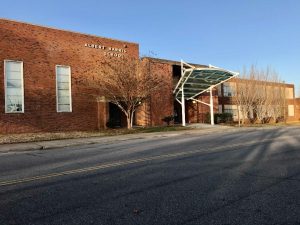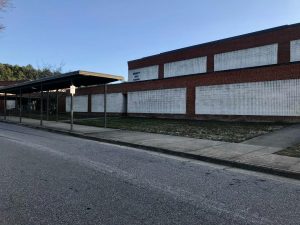By Brandon Martin
As localities like the City of Martinsville consider measures such as reversion to alleviate rising costs associated with education in the wake of declining enrollment, the General Assembly failed to act on two pieces of legislation by State Sen. Bill Stanley, R-Moneta, that would have addressed some of these concerns.
Before adjourning from regular session, the House Privileges and Elections Committee tabled SJ275 and SB1106 was left in the House Appropriations Committee, effectively killing both pieces of legislation.
“We have an obligation under the constitution to provide for our public education, both in the primary and the secondary schools, for every child in Virginia that is eligible. It is enshrined in the constitution under Article 8, Section 1,” Stanley said. “The problem with the article is it seeks to provide a high-quality education, but it doesn’t have any teeth in making sure our children ━ regardless of our zip code, regardless of whatever their financial condition is, and where they live ━ get an equitable education.”
Under SJ 275, Article 8, Section 1 of the Constitution of Virginia would have been amended to state “the General Assembly shall provide for a system of free public elementary and secondary schools with [equitable] educational opportunities for all children of school age throughout the Commonwealth and shall seek to ensure that an educational program of high quality is established and continually maintained.”
Additionally, Section 2 of the article would have been amended to include that the General Assembly “shall ensure that all children of school age are provided with (equitable) educational opportunities.”
Stanley said what it means is that “the child that is living in Petersburg or in our rural areas is getting the same type of education as the child that is attending school in our more affluent areas such as northern Virginia.”
Currently the issue resides with how state funds are allocated using the local composite index (LCI), according to Stanley.
The LCI is calculated using a locality’s true value of real property, adjusted gross income, and taxable retail sales. It determines a school division’s ability to pay educational costs fundamental to Virginia’s Standards of Quality which ultimately decides the share of state funds that a local government can receive.
“That inequity is created because not all education is the same based on our ability at the local level to tax or to take revenues and funnel them into our schools,” Stanley said. “We’ve got to level that off, so we ensure that every single one of our children” in public schools “are provided with an equitable educational opportunity.”
Stanley said rural localities are unable to levy taxes to the same degree as more populated areas.
“There is a different tax base,” he said. “For a family of four in northern Virginia, the average income is over $100,000 whereas in Lee County or in my district, the average income is about $35,000 for that family of four. The capacities to raise taxes at the local level are different as well.”
Del. Mark Sickles, D-Fairfax, dismissed the disparity concerns, and said that the problem lies in the management of available funds to the school divisions.
“Lee County was brought up, and I do believe they have the lowest LCI in the state. By definition, they are our number one priority,” he said. “They get more state funding for their school system than any other jurisdiction. I don’t know why they can’t make better use of it. That money is for everything. I don’t see why people can’t take initiatives, even in rural and small-town Virginia, to solve their own problems.”
Stanley agreed that local governments have a part in solving the issue, but he added that “providing for equitable education” is ultimately a responsibility of the state.
“This is not a solo effort on our part in the General Assembly, nor could it be completely born by the locality. There has to be a level of collaboration through this resolution acknowledging our obligation but also in other legislation that I’ve proposed, like a roof modernization fund where you’re combining state money with matching local money and also getting the private sector involved.”
Under SB1106, which also left without action, Stanley called for an amendment that would create a Public School Assistance Fund that would have provided grants to local school boards “to be used solely for the purposes of repairing or replacing the heating, ventilation, air conditioning, electrical, or plumbing systems or the roofs of public elementary and secondary school buildings in the local school division and any equipment or infrastructure that was damaged as a direct result of a defect in such systems or roofs.”
Stanley said currently, there is a disparity between school divisions, with northern Virginia having new schools “with all the modern bells and whistles” and “the tools in the toolbox” to attract “great teachers” with those resources.
“When you compare it to a school that was built before World War II, they’re not getting the white boards, computers and getting taught computer coding to the same degree as our friends in Loudoun County and northern Virginia,” he said.
Both principal and interest payments could have been paid with the grants.
According to Travis Clemons, executive director of Administrative Services for Martinsville City Public Schools, the stipulations on state funds often disqualify the division from taking advantage of them.
“During my career, every single year, a governor will throw something out for capital, or they try to do something big,” Clemons said. “A lot of the time, a blurb will come out and the media will catch it. We’ll get the phone calls of ‘oh, you’re getting $1 million. What are you going to do with it?’ One hundred percent of the time in the last decade, I’ve had to push back and say ‘actually, we won’t be able to access that funding.’”
Clemons said previous efforts by the state have been limited to payments on interest rates.
“The rest of the amount, the principal balance, is still a loan,” he said. “So, ‘we will give you an offset on a loan’ is really what they are saying. When they do the borrowing type of handouts, then we really can’t take advantage of it because it’s really still a loan.”
Clemons said funds in the form of a grant would be preferable, but even that could have pitfalls.
“If they attach a local required match to such funds, that could be problematic also,” Clemons said. “That is going to be contingent upon school board priorities and what they’ve already budgeted for in the budget. Their priorities compete with other priorities in the local funding stream. If the locality doesn’t want to add the local required effort to it, then that could be problematic.”
Without the available funds to address the ongoing maintenance requirements, Clemons said the division is left to make do with what it has.
“Some things are ongoing, but we have a number of items that are technically at lifespan, but we maintain all of our equipment well. Practically all our equipment technically exceeds its lifespan but regardless, oftentimes mechanicals need to be partially rebuilt, refurbished or completely replaced,” Clemons said. “When you’re dealing with boilers, chillers, and related equipment, it’s a necessary component. Things do not last forever.”
Clemons said the division mostly struggles with heating and air conditioning issues.
“We have a chiller at Albert Harris (Elementary School) that needs a full replacement. The second one needs some refurbishment or replacement also,” he said. “In the middle school, we replaced a chiller in this current year, but there is more work to be done there. Patrick Henry has what is called Bard units. It’s a type of air conditioning and heating unit that is on the wall.”
The units were installed during renovations, Clemons said, and added the same units were installed in the Clearview Early Childhood Center.
“Each individual classroom has its own isolated unit. Those are nearing lifespan also,” he said. “Over time, as those start to individually break down, they will need repairs and fixing.”
Clemons said a single chiller could cost approximately $185,000 to replace. In addition, air handlers at the high school could have a price tag of $150,000 per unit.
“That’s a lot of money to ask for in a single chunk, and to do annually,” Clemons said. “In recent history, we’ve been getting cuts based on enrollment, both locally and statewide.”
Keith Scott, director of facilities maintenance for Henry County Public Schools, said the heating and cooling (HVAC) systems are an ongoing capital concern.
“On the top of our list for HVAC equipment is the rest of Bassett High School,” with 40 percent of the equipment remaining from when the school was originally built, Scott said. “We have been updating that equipment in phases as money is available. HVAC equipment has an industry standard of life expectancy and that can vary depending on the type of equipment.”
Scott said the county’s capital improvement plan (CIP) would require approximately $15-20 million to address all the identified needs.
“We plan to update that CIP plan during the 2021-2022 school year and also perform a new facilities assessment,” he said.
“We create a capital improvement list each year and put on an estimated time frame on when we think things will be needed,” Clemons said. “As things surprise us, those things need to be addressed and are ultimately prioritized. Some things can’t wait, like a roof leak that is going to damage things underneath. That’s when we go to city council on the fly and ask for some of the fund balance to be moved and generally, they are amicable to that. Other things, we may opt for a cheaper approach in the meantime, knowing that we could probably get a couple more years out of them if we do a partial fix or something like that.”
Roof repairs also are a constant concern for both divisions.
“All of our buildings have flat roofing, so therein lies an ongoing issue,” Clemons said. “They vary, based on the type of EPDM (ethylene propylene diene terpolymer) material on them. Some of these, we have foam roofs on them, and you don’t always know when they are going to need repairs. Sometimes a leak develops, and we weren’t expecting it. Then we have to evaluate it over time to see when it needs complete replacement.”
Scott said each of the roofs for the county have a 20-year warranty and Laurel Park Middle School is next in line to receive an upgrade.
“We perform a facilities assessment on our buildings and roofs every 10-15 years,” Scott said. “We monitor service calls for roof leaks and review our roof study to determine when it’s time to replace these roofs.”
With a limited budget due to dropping enrollment, Clemons said it’s hard to address each item on the CIP list.
“We have a limited amount of money in the budget every year. Generally, we have around $200,000 in there, but that’s not just for capital improvements,” he said. “That’s also to support all of our custodial supplies and general things we need annually. We are forced to manage in that range, so we can’t really afford to do the big projects without going to city council every time we need something as a separate part of the budget and not part of the normal budget process.”







